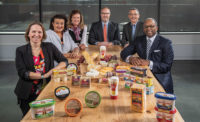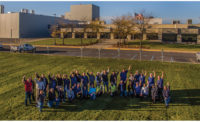
In July of 1994 Dairy Foods debuted an exclusive feature that looked at the upper echelon of the dairy industry. The Dairy Foods Top 50, which would evolve into the Dairy 100T, was a four-page article that began with a question:
"How many times have you wondered which are the nation's largest dairies." The story went on to say that the time for guessing was over. And each year since, Dairy Foods has produced what we believe is the most complete and accurate portrait of the powers-that-be in the industry.
The past 10 years have brought a lot of change to the dairy business. And the past years has brought some serious economic challenges to the industry.
A comparison of the lists from 1994 and 2003 reflects much of that change.
To begin with, there were just four companies in 1994 with sales of a billion dollars or more. The top 10 had sales totaling about $10 billion. This year there are 20 companies in the billionaires club. The top 10 in 2003 represents about $28 billion in sales. The consolidation race has put more business into a smaller number of hands.
A look at the sales figures of the top tier compared to those of a year ago, reflects the economic environment of both the dairy industry and the nation as a whole. There wasn't much growth in fiscal year 2002, thanks as much to record low raw milk prices as to the overall slumping economy.

Ten years gone
When the first Top 50 was compiled with 1993 fiscal year sales figures, Suiza Foods hadn't been around long enough to be listed. Companies like Borden Inc., and Southern Foods, and the Morningstar Group were in the top 20 however, and would later become part of Suiza and then Dean Foods.Bols Wessanen which was No. 7 in 1994, later became the foundation of National Dairy Holdings which is ranked 6th this year.
Dean Foods was ranked No. 3 in 1994 with sales of $1.4 billion. Kraft Foods was at the top with estimated sales of about $4 billion. Kraft's reported dairy sales in 2003? Again, about $4 billion.
Some companies have grown substantially in the past 10 years, whether through acquisitions or through more organic market expansions. Schreiber Foods, Green Bay, Wis., was No. 5 in 1994 with an estimated $925 million in sales. This year, the private label cheesemaker jumped up a few places to get back to No. 5, but it is now doing more than $2 billion annually.
Dreyer's Grand Ice Cream of Oakland has triple the sales it had ten years ago, and it has climbed from No. 16 to No. 11. As more and more business has been consolidated into fewer companies, independently owned companies have had to grow to keep pace or to avoid being absorbed. By more than doubling its 1994 sales of $350 million, Wells Dairy, Le Mars Iowa, has merely managed to stay in the top quadrant. The maker of Blue Bunny ice cream was ranked 22nd in 1994 and 25th in 2003. HP Hood also is doing about twice as much business in 2002 as in 1993. It's now ranked 19th-up from 29th just two years ago. But in 1994, Hood was ranked 12th .
Over the years, the Dairy 100 feature has changed, too.
The Top 50 was organized much differently from this year's Dairy 100. Cooperatives were broken off into a separate table for instance, whereas cooperatives are now listed with other processors, and only their processing revenues are tabulated.
In a similar vein, captive dairies were not listed in 1994, due to the difficulties of separating in-store sales of other dairy products from those manufactured by a grocery chain's own dairy plants. For companies like Kroger, Safeway, and HEB we now list reported figures or reliable estimates of their dairy processing revenues.
Economic challenges
"Of late, the struggling economy has motivated all major food companies, regardless of specialty, to straighten up and fly right. Dairies are heeding consumer demands for quality and value,and striving to differentiate their products and communicate
their benefits."
The preceding paragraph is not from a recent market report, but from the story that accompanied the 1994 Top 50. What goes around comes around.
Fiscal year 2002 was a tough year for many business segments, acquisitions have all but come to a halt, infrastructure improvements are mostly on the backburner, and growth has been hard to come by. But the general feeling in the food industry was a bit more optimistic than elsewhere. After all, people have to eat, we kept hearing. And while they may not be dining out as much, consumers were likely to stay close to home, and sooth themselves with comfort foods.
But it hasn't entirely worked out that way. In the food segments, acquisitions are off, construction has slowed and growth, well it's not a piece of cake.
Many food processors are finding that the usual pathways to organic growth -- brand building and product innovation -- just aren't as clear-cut as they were just a couple years ago. And as the dairy industry is still emerging from a commodity mindset, it's even tougher to justify the expense of new introductions and technological innovations during a slow economy.
Some of the largest companies in our Dairy 100 make their living selling cheese to the foodservice industry, and much of it in so-called "quick service" restaurants. When sales of cheeseburgers and pizzas start to drop, these companies feel it.
In addition, dairy processors -- especially those that rely heavily on the sale of commodity products -- have had their own unique set of challenges to deal with in recent months. The principle of supply and demand took its toll on cheese and whey manufacturers, who just a couple years ago were reaping the benefits of increased pizza sales and growing use of whey in food formulation. Smart processors cranked up operations and ultimately flooded the markets with cheese and whey until the prices began to drop. Because dairy prices are all connected to the federal price structures, milk, cheese and butter prices went into the tubes
together and stayed there for months. That would seem like a good thing for dairy processors, but those that sell dairy products as ingredients to other food processors have been getting less per pound of ingredient.
In fact, retail prices for dairy products including milk and cheese appear to have dropped along with the commodity prices. According to recent market data, dollar sales for milk and cheese have dropped measurably and leveled noticeably, while unit sales have been more even-keeled.
On a more positive note, the commodities markets appear to have righted themselves in recent weeks, as raw milk and processed dairy production have both slowed to some degree. Cheese prices are back to normal levels and milk prices are following. With the broader economy showing some signs of new life, brighter days could be right around the corner.
Now let's look at what's going on with some of the top dairy companies:
Dean Foods Co. (No. 1) Dean Foods' $8.1 billion in annual sales means it does twice as much business as the next largest entry, the dairy units of Kraft Foods. The Dallas company-the product of a series of mergers and acquisitions orchestrated by current chairman Gregg Engles, and former chairman Howard Dean -- is certainly the 800-lb gorilla of the industry. And it's acting like it.
In the past year Dean has pumped marketing muscle into national branded products like Hershey's Flavored Milks and Drinks, Folgers' Jakada coffee drinks and Marie's salad dressing, while building efficiencies in the Dean Dairy Group.
Dean's big-company mentality in promoting Hershey's, combined with the continued strong growth of flavored milk, may be part of the reason why companies from other beverage segments are hustling to bring dairy-based beverages to market.
For our purposes it's difficult to show how the company has grown from a sales perspective in 2002. Last year's table indicated an estimate of $9.7 billion, which may have been a bit overstated. Quarterly and year-end financial statements coming out of Dallas indicate continued growth at the home of the Chug, so it's hard to say that Dean's sales are down.
Also, while there has been a scarcity of acquisitions in the dairy business and elsewhere, Dean has actually made a couple, including the Kohler Foods Division of Michael Foods, and the outstanding shares of Horizon Organic Dairy. And its Meadow Gold unit plans to locate a new plant and distribution facility in Las Vegas.
If Dean Foods is lying low during this slowdown, it will be really interesting to see what the company does when the economy re-ignites.
Kraft Foods (No. 2) As a brand name marketer of cheese that is often produced by other manufacturers, Kraft should have been in position to take advantage of low commodity prices in the past year. But the Northfield, Ill. company reported no growth in its dairy business in 2002. The Kraft name, however, has been leveraged as a co-brand in a variety of the company's prepared foods products including StoveTop Oven Classics, Taco Bell Home Originals, and Nabisco Cheese Nips. For these innovations, Kraft was recognized as Dairy Foods' New Products company of the year in 2002. But lately, the Kraft name has appeared in a more troubling context. The company's stock dropped a bit in July when two key executives exited suddenly. Analysts speculated that the departure of Michael Polk (who defected to Unilever) and Irene Rosenfeld might signal trouble at Kraft. The news came just a week after the company announced that it was shifting its marketing approach slightly due to concerns about obesity lawsuits.
Land O' Lakes (No. 3) While fostering its already well-recognized brand, the Minnesota cooperative has also sold a couple plants this year. It also seems to have sold less dairy products, as sales were off significantly from 2001. But LOL is still in the top 3 of the Dairy 100, and in that sense, it's the largest processing co-op in the country.
Saputo Inc. (No.4) Canada's largest dairy processor jumps up a spot this year, after having been nudged out of the top 10 back in 2000. But Saputo is not just a Canadian concern. With offices in Montreal and in the Chicago area, and 14 plants in the United States, Saputo is truly a North American player, and one that keeps growing. Sales were actually down slightly in 2002, but with such a large portion of its business in cheese, that shouldn't be a major concern.
Schreiber Foods (No. 5) Now here's a company that defied conventional expectations in 2002. Primarily a manufacturer of commodity cheese, the big company from the little town of Green Bay, Wis., derives much of its business from the sale of cheeseburgers. Yet Schreiber's sales grew from $1.5 billion in 2001 to $2.3 billion in 2002, according to sources close to the company-this at a time when foodservice sales are presumably slowing. Of course, there was the matter of the 2002 acquisition of Raskas Foods-a company which had billed itself as the largest private-label cream cheese maker in the United States. With bagels having become a staple of office grazing, Schreiber must be going like gangbusters in that arena. And with 16 plants, this is a company that can deliver.
And more surprises may be in store. With the announcement in May that it will acquire the cream cheese and sour cream assets of a ConAgra plant in Missouri, Schreiber's President and CEO Larry Ferguson was uncharacteristically chatty about future plans.
"Schreiber's growth strategy targets cream cheese and other dairy products," Ferguson said. "This acquisition enables Schreiber to expand our cream cheese business and further advance toward our vision of being a full-service dairy company."
Will Schreiber give Dean, National Dairy, and Hood a run for their money? Was Ferguson simply talking about a wider variety of cheeses and cultured products? He's not saying. But stay tuned.
National Dairy Holdings (No. 6) The second largest full-line dairy company in the United States, National Dairy is not as enigmatic as it was a year or two ago. An attempted merger with HP Hood has made the company a household name in the dairy industry. Speaking of names, the Marigold division has changed its name to Kemp's, while Heluva Good remains Heluva Good. National Dairy's overall sales were down slightly in 2002 from $2.14 billion to $2.04 billion. For a company that was brand new two years ago, that's probably not too alarming. The deal with HP Hood did not come to complete fruition, but the companies have formed a partnership of sorts with the top executive from each taking a position on the other's board. Both companies say it will allow the kind of synergies that were driving the merger discussion in the first place.
Dairy Farmers of America (No. 9) Dairy Farmers of America actually dropped a couple spots this year, but don't let that fool you. As a 50% owner of National Dairy and a participant in a number of other joint ventures, DFA is not only the largest (by member) farm cooperative in the United States, it is also one of the largest processors. Processed dairy sales are actually down by more then $400 million from two years ago, but the landscape was different then, with National Dairy still in its birth stage and DFA still a partner in Dean's predecessor Suiza Foods. DFA still operates 27 plants of its own from Pennsylvania to California. As a result of the partnership between Hood and National Dairy, DFA will also become a stakeholder in Hood.
Dreyer's Grand Ice Cream (No. 11) Dreyer's has drawn a lot of attention in the past year as it wrestled with governmental concerns over the merger with Nestl? Ice Cream Partners (No. 27). The result is the creation of the largest ice cream concern in North America. The combined company will most likely join the top 10 next year. Meanwhile, Dreyer's continued to grow its own business in 2002, with sales totaling more than $1.3 billion.
Methodology
For the 10th annual Dairy 100, Dairy Foods solicited the top companies in the industry through emails, faxes, and phone calls. In cases where the company did not wish to divulge dairy-specific sales figures, estimates were made using financial report information, and industry experts. The sales figures are for dairy products or products dairies could make. That means juice and non-dairy creamers are counted, but pizzas, pickles and coffee are not.
Sales represent company revenues and are expressed in million of dollars, US. For Canadian companies, conversions were made at the time the information was reported in June or July of this year, for both '02 and '01 sales. Company descriptions reflect or note recent changes, including acquisitions, plant closures and personnel changes, but sales figures are for the most recently completed fiscal year available. The Dairy 100 is archived on our Website at www.dairyfoods.com.
Where did they go?
This was another year when few companies disappeared from the Dairy 100. McCadam Cheese of N.Y., and its Chateaugay plant have become part of Agri-Mark Inc., No. 32. Raskas Foods, St. Louis, was purchased by No.5 Schreiber Foods in November of 2002. The name Superbrand disappeared from our list, as it is no longer used by No. 26, which is now known as Winn-Dixie Dairy Products. New to the list this year are Instantwhip Foods, No. 64, and Milkco Inc., No. 74."How many times have you wondered which are the nation's largest dairies." The story went on to say that the time for guessing was over. And each year since, Dairy Foods has produced what we believe is the most complete and accurate portrait of the powers-that-be in the industry.
The past 10 years have brought a lot of change to the dairy business. And the past years has brought some serious economic challenges to the industry.
A comparison of the lists from 1994 and 2003 reflects much of that change.
To begin with, there were just four companies in 1994 with sales of a billion dollars or more. The top 10 had sales totaling about $10 billion. This year there are 20 companies in the billionaires club. The top 10 in 2003 represents about $28 billion in sales. The consolidation race has put more business into a smaller number of hands.
A look at the sales figures of the top tier compared to those of a year ago, reflects the economic environment of both the dairy industry and the nation as a whole. There wasn't much growth in fiscal year 2002, thanks as much to record low raw milk prices as to the overall slumping economy.


